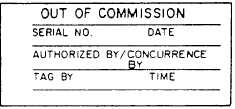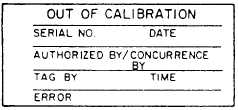Figure 1-4.—Out-of-commission label (colored red).
Out-of-Commission Labels
Out-of-commission labels are RED labels (fig.
1-4) used to identify instruments that do not work
properly because they are defective or isolated
from the system. This indicates the instrument
cannot be relied on and must be repaired and
recalibrated, or be reconnected to the system
before use.
Out-of-Calibration Labels
Out-of-calibration labels are ORANGE labels
(fig. 1-5) used to identify instruments that are out
of calibration and may not work properly. This
label indicates the instrument may be used for
system operation only with extreme caution.
ENFORCEMENT
The tag-out log is kept in a designated space,
usually CCS. Supervisory watch standers review
the log during watch relief. Active tag-outs are
spot checked periodically to ensure tag integrity
is being maintained.
An audit of the tag-out log is conducted by
the EDO every 2 weeks while in port, prior to
getting under way, and weekly if in the yards or
at a maintenance availability. Results of the audit
are reported to the engineer officer.
Figure 1-5.—Out-of-calibration label (colored orange).
To ensure that tag-out procedures are enforced
properly, the engineer officer checks the log
frequently, noting any errors and bringing them
to the attention of the proper personnel.
ENGINEERING OPERATIONAL
SEQUENCING SYSTEM
The Navy has developed a system known as
EOSS. Essentially, the EOSS is to the operator
as the PMS is to the maintainer.
Main propulsion plants in Navy ships are
becoming more technically complex with each new
class of ship. Increased complexity requires
increased engineering skills for proper operation.
Ships that lack experienced personnel have
material casualties. These casualties jeopardize
operational readiness. Rapid turnover of engineer-
ing personnel further compounds the problems
of developing and maintaining a high level of
operator and operating efficiency.
The Navy has been increasingly aware of these
problems. An evaluation of the methods and
procedures used in operating engineering plants
has been completed. The results of these studies
show that sound operating techniques were not
always followed. Some unusual circumstances
found to be prevailing in engineering plants are
as follows:
l
l
l
The information needed by the watch
stander was scattered throughout publica-
tions that were not readily available.
The bulk of the publications were not
systems oriented. Reporting engineering
personnel had to learn specific operating
procedures from “old hands” presently
assigned. Such practices could ultimately
lead to misinformation or degradation of
the transferred information. These practices
were costly and resulted in nonstandard
operating procedures, not only between
adjoining spaces, but also between watch
sections within the same space.
Posted operating instructions often did not
apply to the installed equipment. They
were conflicting or incorrect. Procedures
for aligning the various systems with other
systems were not provided.
1-12




